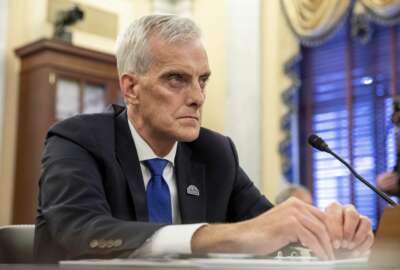Pentagon says full-year CR would cut its 2022 spending by more than $20B
Major reductions in military accessions, a civilian hiring freeze and cuts to PCS moves are all strong possibilities under a full-year continuing resolution,...
The government has been running under a continuing resolution for three and a half months now, and at the moment, there aren’t any clear signs of a spending agreement that would head off a full-year CR. Pentagon leaders say that would be extremely bad news for the military. Rather than just keeping 2022 spending levels the same as last year, they say it would actually reduce DoD’s available funding by more than $20 billion this year.
From a purely topline perspective, extending 2021 funding for another year would leave DoD only about $8 billion below what officials requested for 2022. But as with all CRs, the much bigger problem is that putting government funding on autopilot leaves the wrong amounts of money in the wrong accounts.
In some cases, it means the money can’t be spent at all. Perhaps the most glaring example is the $3 billion a full-year CR would allocate for the Afghan National Security Force, which no longer exists. Overall, the Pentagon estimates the total loss in spending authority would be about three times the size of the actual topline reduction.
Defense officials say some of the consequences of those misallocations could start showing up very soon, especially in the personnel arena. One reason is the 2022 military pay raise Congress mandated in this year’s defense authorization bill has already taken effect, but under 2021 funding levels, that 2.7% raise isn’t paid for.
“By definition, under a CR, the amount in personnel accounts is flat, so the pay raise costs have to be absorbed. The accounts themselves are flexible, but that doesn’t mean that we have good choices within that flexibility,” Mike McCord, DoD’s comptroller and chief financial officer told the House Appropriations Committee Wednesday. “We’re going to have to look at accessions and [permanent change of station] moves for our troops — those are probably the first and least disruptive things we could do. The next things that we’d have look at that would be more distasteful would be bonuses. Within a flat account, we have to do something to absorb that pay raise, and that’s going to impact our troops in another way.”
And military leaders say those cuts to onboarding and PCS moves wouldn’t be small ones.
The Air Force, for example, thinks it would have to reduce its planned accessions by about half for the remainder of the year. In the Navy’s case, it would mean cutting those accessions by about 75%, and PCS moves by about 50%, said Adm. Michael Gilday, the chief of naval operations.
“We’ve got about 145,000 sailors at sea. A year ago, we had 10,000 of those billets that were gapped, and we’ve been able to cut that down by more than half. If we cut our accessions by 75%, that’s 23,000 sailors, and we are again going to exacerbate that gap at sea — where we need it the least,” he said. “We’re also trying to entice sailors as our best sailors to stay in the Navy, but we’re going to have to cut reenlistment bonuses, incentive bonuses. So that’s also going to exacerbate those gaps and sea.”
Military officials say in many cases, the CR would also mean permanently losing access to incoming personnel they’ve already successfully recruited. That’s because the slowdown in new accessions would mean they’d have to ask recruits to stay in the military’s delayed entry pools for another year. Many, they fear, won’t wait that long.
And for the civilian workforce, a full-year CR is also likely to mean at least a partial hiring freeze, said Gen. John Raymond, the chief of space operations.
“One of the biggest benefits we realized after establishing the Space Force is our ability to attract incredible talent. This talent is highly technical, it’s highly educated, and it’s sought after. And they have other options,” he said. “If we enter into this delay and have to reduce accessions and put hiring freezes in place to help pay for the much-needed and deserved pay raise, they’re going to go to other places, and those are people that we will not be able to get back.”
In other areas of the budget, like procurement, sustainment and military construction, the negative effects of a CR would take longer to appear, but have “cascading” effects that would lead to higher spending over the long run, military officials say.
Under continuing resolutions, “new starts” are prohibited. DoD officials say that means only a “handful” of about 100 previously-planned military construction projects would happen this year across the active duty force, and none in the National Guard and Reserve.
The new start prohibition also applies to acquisition programs. In the Army’s case, it would affect 71 separate procurements, said Gen. Joseph Martin, the Army’s vice chief of staff.
“We’ve got 24 of our signature programs that, in some form or fashion, are going to be in the hands of soldiers, whether it’s in an operational testing environment, soldier touchpoints, or actual fielding by 2023. With the restraints of the CR, the timing of 19 of those 24 programs will be impacted,” he said. “You can’t get back time, but it’s also that the resources that we could have spent this year are resources we’re going to have to spend next year, which means it’s twice the cost. So it’s a huge impact on our modernization and maintaining our ability to compete in the future.”
Defense officials said the CR would leave DoD’s operating and maintenance accounts more than $5 billion short of what was planned for this year. Since those funds pay civilian employee salaries, furloughs are at least a possibility. Another option is to delay military training exercises and make more cuts to facility maintenance, other big bills that are funded from O&M accounts.
Gilday said the loss of O&M dollars combined with the prohibition on new starts would set back the Navy’s long-needed shipyard modernization program by one to years, and have a direct and serious effect on its ability to maintain its ships.
“I creates a situation where you have maintenance leading operations, which is not where you want to be,” he said. “Our maintenance availabilities for those nuclear powered vessels are really planned toe-to-heel. As soon as we’re done with one, we’re bringing in the next, because that’s how we’re most efficient, and this is going to cause a perturbation. We saw this during sequestration, and we’re still catching up a decade later.”
Copyright © 2025 Federal News Network. All rights reserved. This website is not intended for users located within the European Economic Area.
Jared Serbu is deputy editor of Federal News Network and reports on the Defense Department’s contracting, legislative, workforce and IT issues.
Follow @jserbuWFED







